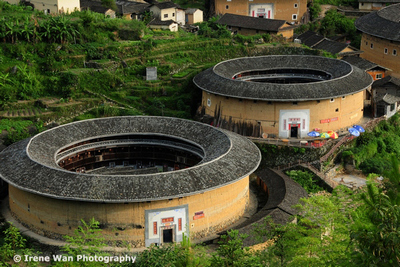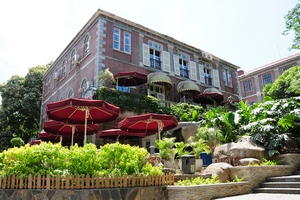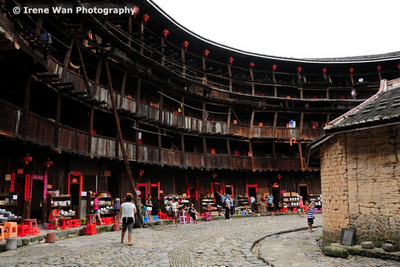Home > Destinations > Asia > China > 4-Days Xiamen Essence Tour



4-Days Xiamen Essence Tour
廈門
Xiamen - Gulangyu- Tulou
廈門 - 鼓浪嶼- 永定土樓
| Day 01 | Hong Kong - Xiamen 廈門 - Gulangyu 鼓浪嶼 |
Arrival in Xiamen 廈門, capital of Fujian Province (just over an hour flight time) which is sometimes still called Amoy in the West.
Upon arrival you will be met by your local guide and taken to the pier before making a crossing of just a few minutes by boat to Gulangyu island 鼓浪嶼 (literally meaning “the islet where waves roll like drums”), a small but charSming island, which is one of a kind and hosts some excellent colonial architecture. Founded in the Ming dynasty, Xiamen was a major trade port in the south of the country, and at the time of the Manchu invasion (the Qing, who were the last dynasty of Imperial history) became one of the points of retreat for the Ming armies, under the leadership of the famous general Koxinga (renowned Chinese merchant, pirate and bureaucrat, equally well known in Taiwan for having repelled the Dutch in the 17th century). After several European invasion attempts (Portuguese, British, French and Dutch who all saw the commercial potential of the island), it was ultimately after the Opium Wars (see Day 1) in the 19th century that Xiamen became a foreign concession and Gulangyu the home of the European and Japanese colonisers. Today it is a pleasant maze of narrow roads, shaded alleys dotted with banyan trees, palm trees, baroque villas (numbering more 1000 on the island as a whole), and typical Chinese housing. Save for the permanent crowds in the area around the pier, the island offers several secluded corners (including some small beaches), allowing you to get away from the bustle of a Chinese megalopolis and above all its traffic, as cars are banned on the island.
We will take a walk on the island to visit some ancient foreign consulates, churches and art deco style buildings. After admiring the views from the Sunlight Rock, which dominates the entire island, you can also visit, if you wish, the Koxinga Memorial 鄭成功紀念館, a statue of a national hero gazing proudly at the mainland.
In China, Gulangyu is also know by the name “Piano Island” due to the interest of the locals in this instrument, which was taught in the schools established by the Europeans from 1913, giving rise to some great pianists.
Your day will continue with a visit to the pleasant Shuzhuang garden 菽莊花園. Here you can find several pavilions, and pengjing which literally means “countryside in a flowerpot” and which is better known as Bonsai, and is of Chinese origin not Japanese, contrary to popular belief. You can even spend the end of your day relaxing on the beach if that’s where your feet take you.
For the braver amongst the travellers, and certainly those who have a more refined sense of direction, you can take a night-time stroll about the island where calm reigns supreme and cats have dominion of the streets.
| Day 02 | Gulangyu 鼓浪嶼 - Xiamen 廈門 - Yongding 永定 |
Return to Xiamen by boat and transfer to your journey to Yongding 永定 (around 200km/125 miles away, taking around 4 hours by road depending on the traffic), a region scattered with spectacular Hakka fortresses, or tulou. It is impossible to do an architectural tour of China without visiting these unique structures!
“Hakka” (or “Kejia”) means “guest families” and refers to a branch of Han people who originate in the central plains of China, today numbering more than 80 million people in the world in total. The emigration of the Hakka people from the centre of China to the southern provinces started in earnest under the pressure exerted from the north by the Manchu (future Qing dynasty, the final dynasty in Imperial China) during the Ming Dynasty. Pockets of resistance supporting the Ming Court could be found more or less everywhere in the country, in particular in Xiamen as we will have just seen, and in Taiwan, to where many Hakka people fled and whose descendants make up a portion of the island’s current population.
The integration of the Hakka into the lands where they took refuge proved difficult and quickly descended into a battle with the local communities, who saw the expansion of these “guests” with great suspicion. The architectural style of the tulou is the materialisation of these historical conflicts. Made principally of clay and round or square in shape the tulou are impressive fortresses that sometimes housed many hundreds of people. An isolated microcosm of the outside world, the tulou often contained a temple for ancestor worship and a school in the centre. Its wells, kitchen, and supply areas made the Hakka fortress an almost autonomous entity and one of the most interesting architectural and sociological sites of the country.
The tulou, some of which are listed under UNESCO’s World Heritage project, can be found all over Fujian and Guangdong provinces, but it’s close to the town of Yongding where they are most concentrated. In much the same way as the cave-dwellings you will visit close to Pingyao, the structure of the fortresses and the building materials used allow a pleasant room temperature to be maintained whatever the season.
There are still thousands of such fortresses and a large number of them are still inhabited. The wooden doors still creak, and the red lanterns sway in the wind while the inhabitants go about their business, each one of these fortresses is like its own little village!
You will start your visit with a trip to the Hongkeng fortresses, where you can find Zhencheng lou 振成樓, whose construction dates back to the start of the 20th Century, Kuiju lou 奎聚樓, which is a square style tulou, letting you appreciate the two principal architectural forms of these constructions (a third form, semi-cylindrical, can be seen in Guangdong province and can be visited if you wish to extend your trip – please ask us about this). You will also get to see Rusheng lou 入聲樓, the smallest but probably the best example for observing the Hakka community spirit.
Your visit will end with what is considered as the “King of tulou”, Chengqi lou in Gaobei village. This tulou is notable for its size, with 400 rooms and a history dating back to the start of the 18th century.
Family dinner and night in a tulou.
Note: conditions in tulou are basic but charming. Please consult with us if you want to upgrade accommodation.
| Day 03 | Yongding 永定~ Xiamen 廈門 |
Return journey to Xiamen and visit to the Tianluokeng Tulou Cluster 田螺坑土樓集群, comprising of five fortresses famous for the incredible views of the hills close to Ruiyun lou that they have to offer.
| Day 04 | Xiamen 廈門 - Hong Kong |
- Free time a leisure till transfer to airport.
- Return to Hong Kong or to your hometown.
Have a nice holidays!
Remarks :
Every effort will be made to adhere to the planned itinerary. However, due to weather conditions and reasons beyond our control, changes to the itinerary might occur, for which the company accepts no responsibility.
|
|---|
Newsletter Subscription: 訂閱最新旅遊資訊
Site Map · Privacy Policy 私隱政策(只附英文版)
© 2020 Exotic-Holidays.hk · All Rights Reserved
![]()